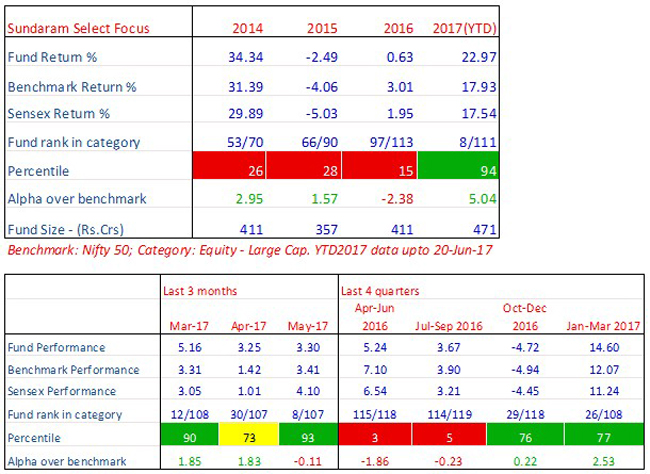|

Click here to know more about percentiles and the colour codes
What do percentiles and their colours signify?
Fund performance is typically measured against benchmark (alpha) and against competition.
Performance versus competition is measured through percentile scores - ie, what
percentage of funds in the same category did this fund beat in the particular period?
If a fund's rank in a year was 6/25 it means that it stood 6th among a total of
25 funds in that category, in that period. This means 5 funds did better than this
fund. In percentile terms, it stood at the 80th percentile - which means 20% of
funds did better than this fund, in that particular period. If, in the next year,
its rank was 11/26, it means 10 other funds out of a universe of 26 did better than
this fund - or 38% of funds did better than this one. Its percentile score is therefore
62% - which signifies it beat 62% of competition.
Most fund managers aim to be in the top quartile (75 percentile or higher) while
second quartile is also an acceptable outcome (beating 50 to 75% of competition).
What is generally not acceptable is to be in the 3rd or 4th quartiles (beating less
than 50% of competition). Accordingly, we have given colour codes aligned with how
fund houses see their own percentile scores. Green colour signifies top quartile
(percentile score of 75 and above), yellow or amber signifies second quartile (percentile
scores of 50 to 74) and red signifies 3rd and 4th quartile performance. A simple
visual inspection of colour codes can thus give you an idea of how often this fund
has been in the top half of the table and how often it slips to the bottom half.
A great fund performance is one which has only greens and yellows and no reds -
admittedly a tall ask!
WF: The fund's performance seems to have turned around sharply in recent months. What are some of the changes that you have made since taking over management of this fund?
Rahul: In terms of process, we did some streamlining in investment process keeping in mind the concentrated large cap investing style and my work experience in perspective. The fund follows a bottom up approach in stock picking based on in-house research and fund managers conviction and would generally be focussed around 3-4 themes . Many portfolio changes were also done after taking over the fund in Oct-16. Broadly the portfolio construction was repositioned around the following 3 themes 1) Consumer discretionary 2) Government reforms 3) Domestic cyclicals. Some of the high conviction ideas added to create sizeable positions included stocks like Kotak Bank, Maruti, IOC, Larsen and ITC. . Also some good quality consumer names like Hero Motors and Crompton Consumer were added to the portfolio during the demonetisation driven market correction. All the measures taken above have helped improve performance of the fund in the recent months.
WF:What does your attribution analysis suggest as key alpha drivers over the last 6 months?
Rahul: There are 3 broad buckets of alpha generation in the fund. The fund has been running a large Underweight in Pharma and IT over the last 6 mths. Also the fund picked some good quality consumer and financial names (some mentioned above) in the demonetisation driven market correction which have outperformed since then. Thirdly, a contrarian call on being overweight on ITC has been an alpha driver as well. There were a lot of concerns that GST would be negative for the stock but over time the worries got diluted and the stock has given ~ 40% returns ytd.
WF: What are your key over and underweight sectoral positions in the fund?
Rahul: Currently - the key overweight sectors are private sector banks and consumer discretionary; key underweights are IT, Pharma, Cement.
WF: Would you describe this fund as a concentrated large cap portfolio or a well-diversified large cap portfolio?
Rahul: The fund runs a concentrated style with a 30-35 stock portfolio with >80% in large caps. The fund manager believes that this range is a manageable number of stocks to develop conviction and therefore sizing. A "focussed" portfolio can enhance the "reward" potential and buying more number of stocks for sake of diversification can sometimes add to the "risk". Thus a 30-35 stock portfolio tries to capture the benefits of a concentrated style while at same time avoiding the downside of being over diversified.
WF: What is your call on markets now and what do you see as the key drivers going forward?
Rahul: We think that the economic upturn is improving and are cautiously optimistic on the markets. Improving quarterly performance is key to getting a broad based earnings growth. We expect GST to cause only a short term disruption but should be quite positive for the listed companies and market from a medium term perspective. Locally - Progress of monsoon, GST progress and festive season demand ahead would be key short term drivers.
Share this article
|